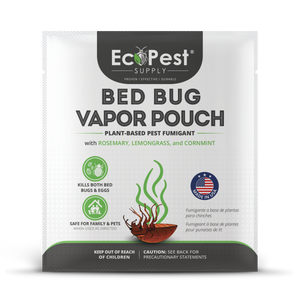
Many people notice a few bite marks during the night and suspect they might have a bed bug infestation. If you are worried about the same thing, you might be wondering what the best way to confirm the presence of the pests and even eliminate them entirely from your home is.
Luckily, there are some fantastic tools on the market, such as bed bug glue traps, but how efficient are they, and where to put the glue traps for bed bugs.
Keep reading to find out all the details and ensure you have a bug-free home.

What Are Bed Bug Glue Traps?
A bed bug glue trap is one of the best tools you can use to determine the presence and the severity of bed bug infestation in your home.
The bed bug population in the United States and around the world is on the rise, and moreover, there is a new tropical species that is even harder to capture with regular interceptor traps. Because the bed bug evolved and their climbing skills improved, they are more likely to escape traps. This is why setting up high-quality bed bug traps that work like those with glue on them, in conjunction with bed bug interceptors, might be the best way to deal with the problem.
How Do Bed Bug Traps Work?
Now that we are familiar with the bed bug sticky traps, you might be wondering, “How do bedbug traps work?” The easiest way to understand is that the sticky surface captures all the bugs crossing over, and they are not able to move.
Bed bugs are attracted to humans and animals in the home, as they need blood to survive. The primary choice is human blood, so they love to hang around the bed and feed at night. This might sound like a terrible thing, but it’s also an opportunity to set up traps in suitable locations.
Bed bugs don’t fly or jump, so they must cross some distance to get to humans in the bed. Thus, getting a few high-quality glue traps will lure them out, and the glue will hold them in one place.
How to Use Bed Bug Traps?
If you want to know how to set bed bug traps, the process is extremely easy. Glue traps are designed to be simple to assemble, set in the desired position, and replaced after some time.
It’s one of the best tools to determine if you have any bed bugs in your home, and many people take a few glue traps on vacations and test the hotel beds as well. Considering how easy the pests are to accidentally carry in your clothes and luggage back home, it’s a good idea to ensure there are no bed bugs in used beds and hotels.

You can use the bed bug glue trap in three easy steps:
- Open up the box and remove the adhesive liner to reveal the glue;
- Fold the trap to lock the top flaps together;
- Set the traps in designated locations.
Setting up multiple glue traps in different locations is always a good idea. This way, you will cover more surfaces, and potential entry points bed bugs use to get to you. In addition, when using the glue traps, you can evaluate the efficiency of other products, such as specialized bed bug sprays and interceptors.
Where to Put Bed Bug Traps?
Many people wonder, “Where to put bed bug traps, and do bed bug traps work efficiently anywhere?” The simple answer would be that the placement of the glue trap can make a difference in its efficiency.
Bed bugs are attracted to the warmth of the human body and the carbon dioxide we exhale while we sleep, so they usually hide in places near the bed, on the mattress, and on carpets.
But, considering this pest is very small and flat, it can hide practically anywhere in the home, all the cracks in the walls and other confined places. This characteristic makes bed bugs hard to see and capture, so the placement of the glue traps is vital.
It’s recommended to place a few traps at the same time:
- On the floor next to the bed;
- Between the mattress and the box spring;
- Under the bed;
- Around the room;
- Anywhere you notice bed bugs hang out;

Humans in beds act as bed bug bait and will lure the bugs to cross over the sticky surface. This is true for common and tropical bed bugs, so you don’t have to worry about the specific species you are dealing with.
How Effective Are Bed Bug Traps?
Placing and monitoring the traps might be easy, but are bed bug traps effective? Yes, these traps are one of the best ways to confirm the presence of bugs and capture many of them in just one trap.
The glue bed bug trap is beneficial for:
- Confirming the presence of bed bugs, if you are not sure;
- Assessing the severity of the infestation based on the number of bugs captured;
- Lowering the number of bugs and the bites you get during the night;
- Evaluating the efficiency of other pest control products such as Diatomaceous Earth, interceptors, or bug sprays.
So, do bed bug lures work? Yes. It’s even more effective than other products on tropical pests, and it’s effortless to set up.
If you notice you have a more extensive infestation in your home and the glue traps get full faster, you should include additional tools such as specialized laundry detergent, sprays, and DE dusters.

Where to Buy Bed Bug Traps?
There are many glue bed bug traps on the market, but they are not equally efficient.
If you want the best glue bed bug trap, you should consider the ones with high-quality glue, easy to set up, and without any pesticides. While chemicals might kill the pests faster, they are not the safest option for your family and pets.
So, when choosing the glue trap for your bedroom, make sure they are eco-friendly and toxin-free. This way, you won’t worry about the potential dangers of harsh chemicals, and the efficiency is still high.
You will be able to see the results in a few hours or overnight once the bed bugs come out of their hiding places and head to your bed to feed. Considering the glue traps are so versatile, you can even capture the bugs hiding in your mattress and bed frame.
Final Thoughts
Now that you know how effective the glue traps are and where to place them in your home, you will be one step closer to ending the infestation. While it might not be pleasant to see a lot of bugs captured on the sticky surface of the trap, it’s an opportunity to evaluate the number of pests you are dealing with and act accordingly.
Once you are sure there are no more bed bugs and the glue traps are empty, you can add another layer of protection over your mattress and ensure your home is entirely bug-free.







